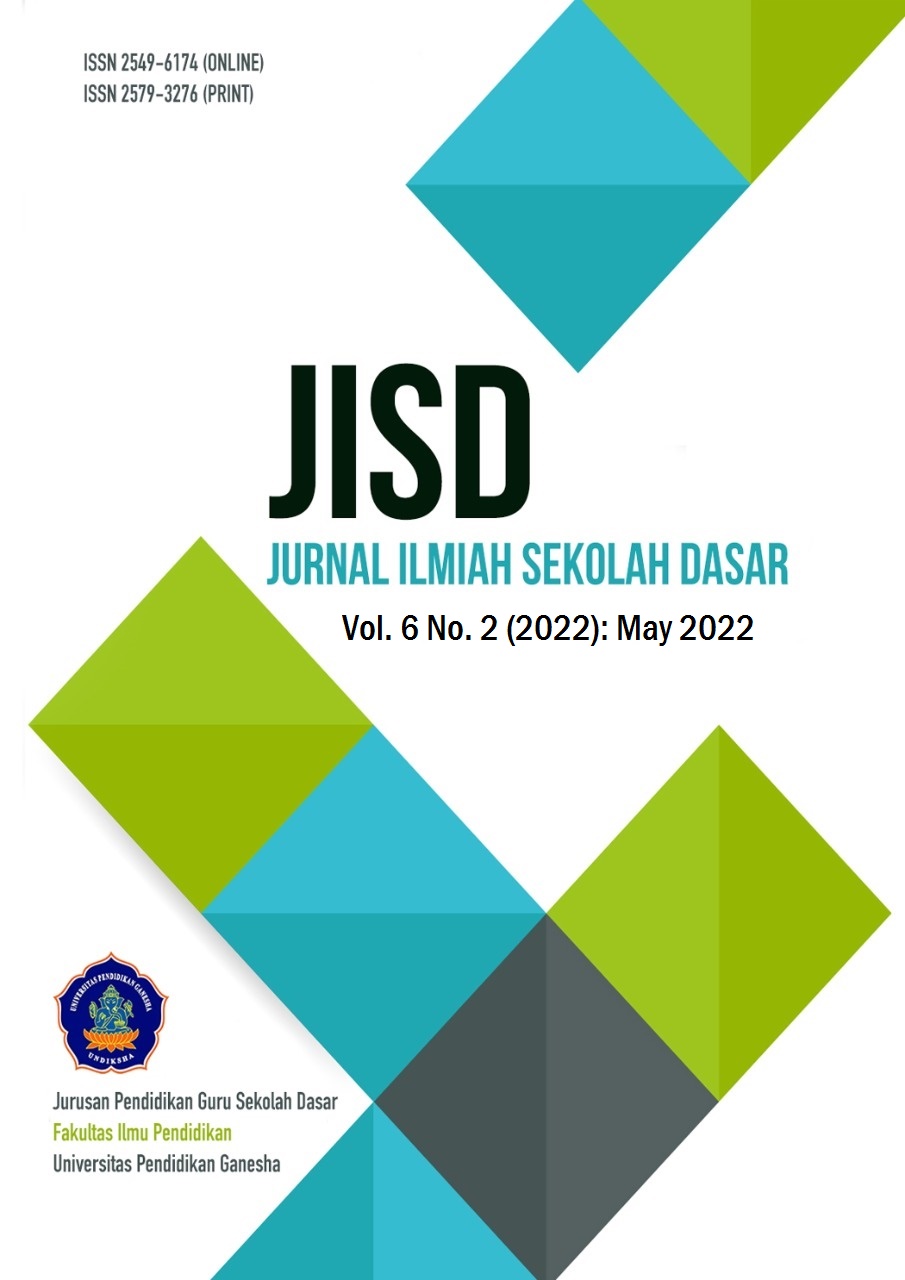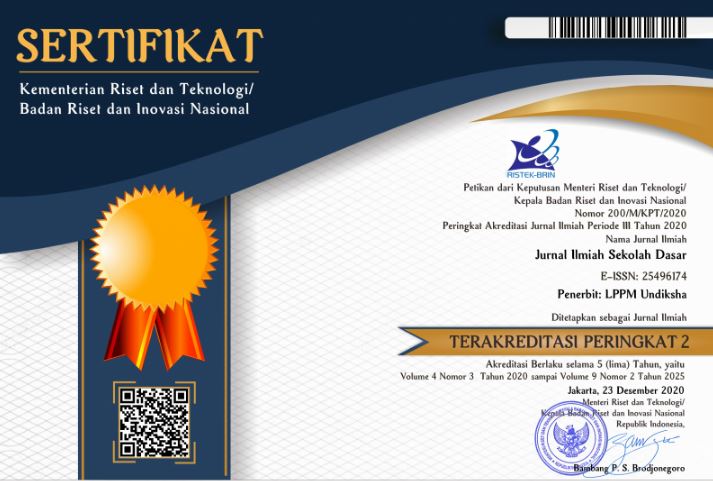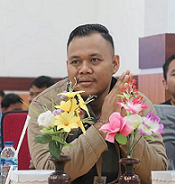The Effectiveness of the Nobangan Learning Model Based on the Traditional Kaili Tribe Game on Students' Learning Interest
DOI:
https://doi.org/10.23887/jisd.v6i2.46207Kata Kunci:
Nobangan Learning Model, Traditional Games, Kaili Tribe, Learning InterestAbstrak
The monotonous learning done by the teacher affects the students' low interest in learning. Students become indifferent and not diligent in following the learning process. This study aims to analyze the effectiveness of the Nobangan learning model based on the traditional game of the Kaili tribe on interest in learning in sixth grade elementary school students. This research uses Quasi Experiment method with Nonequivalent Control Group Design. The population and sample in this study amounted to 17 grade VI elementary school students. The data collection method used a questionnaire technique. The instrument of data collection was in the form of a questionnaire measuring students' interest in learning. Data analysis used paired sample t-test. Based on the results of the study showed that the Nobangan learning model was effectively used in increasing student interest in learning. So it can be concluded that the Nobangan learning model based on the traditional game of the Kaili tribe is effectively used to increase student interest in learning. The nobangan learning model is a learning model that begins with seeking information from the material or pictures that the teacher provides and then strengthens mastery of the material with the task of making questions and answers. At the end of the lesson, the information that has been obtained is recalled through the game of nobangan.
Referensi
Abdillah, A. (2019). Pengembangan Model Pembelajaran Motorik Berbasis Permainan. Jurnal Pendidikan Olahraga, 8(2), 138. https://doi.org/10.31571/jpo.v8i2.1446. DOI: https://doi.org/10.31571/jpo.v8i2.1446
Abduh, M. (2017). Bermain Dan Regulasi Diri (Kajian Teori Vygotsky). In Y. Sulistiyono, L. E. Rahmawati, & G. K. Assidik (Eds.), The Second Progressive and Fun Education Seminar (pp. 595–600). Muhammadiyah University Press. https://publikasiilmiah.ums.ac.id/xmlui/handle/11617/9568.
Ainley, M. (2010). Interest. International Encyclopedia of Education, 612–617. https://doi.org/https://doi.org/10.1016/B978-0-08-044894-7.00611-4. DOI: https://doi.org/10.1016/B978-0-08-044894-7.00611-4
Akmal, A. (2020). Upaya Meningkatkan Minat Belajar Anak Melalui Pembelajaran Sains. Generasi Emas: Jurnal Pendidikan Islam Anak Usia Dini, 3(1), 8–17. https://doi.org/10.25299/jge.2020.vol3(1).5250.
Arlianty, W. N. (2017). An analysis of interest in students learning of physical chemistry experiment using Scientific approach. International Journal of Science and Applied Science: Conference Series, 1(2), 109–116. https://core.ac.uk/download/pdf/193286938.pdf. DOI: https://doi.org/10.20961/ijsascs.v1i2.5130
Asmi, A., Neldi, H., & Khairuddin. (2018). Meningkatkan Minat Belajar Siswa dalam Pembelajaran Pendidikan Jasmani Olahraga dan Kesehatan melalui Metode Bermain pada Kelas Viii-4 Sekolah Menengah Pertama Negeri 2 Batusangkar. Jurnal Menssana, 3(1), 33–44. https://doi.org/10.24036/jm.v3i1.64. DOI: https://doi.org/10.24036/jm.v3i1.64
Astriya, B. R. I., & Kuntoro, S. A. (2015). Pengembangan Kreativitas Dan Minat Belajar Anak Usia 3-4 Tahun Melalui Permainan Konstruktif. Jurnal Pendidikan Dan Pemberdayaan Masyarakat, 2(2), 131–144. https://doi.org/10.21831/jppm.v2i2.6329. DOI: https://doi.org/10.21831/jppm.v2i2.6329
Aypay, A. (2016). Investigating The Role of Traditional Children’s Games in Teaching Ten Universal Values in Turkey. Eurasian Journal of Educational Research, 62, 283–300. https://doi.org/http://dx.doi.org/ 10.14689/ejer.2016.62.14. DOI: https://doi.org/10.14689/ejer.2016.62.14
Azizah, & Rahma, S. (2021). Penerapan Permainan Tradisionalterhadap Minat Siswa Dalam Mengikuti Pembelajaran Pendidikan Jasmani, Olahraga Dan Kesehatan (Studi Pada Sdn Pelem Ii Kecamatan Kertosono, Kabupaten Nganjuk). Creative Of Learning Students Elementary Education, 4(2), 157–168. https://jurnalmahasiswa.unesa.ac.id/index.php/9/article/view/22218.
Azizah, Rahman, A., & Ma’asi, D. (2021). Pengaruh Pembelajaran Jarak Jauh Luar Jaringan (PJJ Luring) Terhadap Minat Belajar Siswa. Collase, Journal of Elementary Education, 4(4), 517–527. https://doi.org/10.22460/collase.v4i4.7480.
Azizah, & Regita, M. (2021). Pengembangan Model Pembelajaran Nobangan Berbasis Permainan Tradisional Suku Kaili Terhadap Nilai Keaktifan Siswa Kelas IV Sekolah Dasar. Elementary School, 8(1), 199–206. https://doi.org/10.31316/esjurnal.v8i1.1103. DOI: https://doi.org/10.31316/esjurnal.v8i1.1103
Azizah, Sani, N. K., Aras, N. F., & Adriana, L. (2020). Pengembangan Model Pembelajaran Nobangan Berbasis Permainan Tradisional Suku Kaili terhadap Nilai Karakter Cinta Tanah Air. Jurnal Moral Kemasyarakatan, 5(2), 43–50. https://doi.org/10.21067/jmk.v5i2.4966. DOI: https://doi.org/10.21067/jmk.v5i2.4966
Effendi, A., & Hartati, S. C. Y. (2018). Penerapan Permainan Tradisionalterhadap Minat Siswa Dalam Mengikuti Pembelajaran Pendidikan Jasmani, Olahraga Dan Kesehatan (Studi Pada Sdn Pelem Ii Kecamatan Kertosono, Kabupaten Nganjuk). Jurnal Pendidikan Olahraga Dan Kesehatan Volume 06, 6(1), 45–49. https://jurnalmahasiswa.unesa.ac.id/index.php/9/article/view/22218.
Farhurohman, O. (2017). Hakikat Bermain Dan Permainan Anak Usia Dini Di Pendidikan Anak Usia Dini (PAUD). As-Sibyan, Jurnal Pendidikan Anak Usia Dini, 2(1), 27–36. http://103.20.188.221/index.php/assibyan/article/view/1334.
Gultom, S., Hutauruk, A. F., & Ginting, A. M. (2020). Teaching Skills of Teacher in Increasing Student Learning Interest. Budapest International Research and Critics Institute-Journal (BIRCI-Journal), 3(3), 1564–1569. http://www.bircu-journal.com/index.php/birci/article/download/1086/pdf. DOI: https://doi.org/10.33258/birci.v3i3.1086
Khodijah, S., . S., & . T. (2018). Strategy for Increasing The Students’ Interpersonal Communication Skills through Problem-Based Learning. International Journal of Educational Research Review, 3(4), 150–158. https://doi.org/10.24331/ijere.457979. DOI: https://doi.org/10.24331/ijere.457979
Kickmeier, M. D., Mattheiss, E., Steiner, C. M., & Albert, D. (2011). A Psycho-Pedagogical Framework for Multi-Adaptive Educational Games. International Journal of Game-Based Learning. https://doi.org/10.4018/ijgbl.2011010104. DOI: https://doi.org/10.4018/ijgbl.2011010104
Krapp, A. (1999). Interest, motivation, and learning: An educational-psychological perspective. European Journal of Psychology of Education. European Journal of Psychology of Education, 14, 23–40. https://doi.org/10.1007/BF03173109. DOI: https://doi.org/10.1007/BF03173109
Laela, A., & Ema, A. (2019). Meningkatkan Minat Belajar Anak Melalui Metode Bermain Menggunakan Alat Permainan Edukatif (APE) Di Kelompok B. JURNAL CERIA, 2(6), 209–301. https://doi.org/10.22460/ceria.v2i6.p295-301. DOI: https://doi.org/10.22460/ceria.v2i6.p295-301
Lestari, I. (2013). Pengaruh Waktu Belajar Dan Minat Belajar Terhadap Hasil Belajar Matematika. Formatif: Jurnal Ilmiah Pendidikan MIPA, 3(2), 115–125. https://doi.org/http://dx.doi.org/10.30998/formatif.v3i2.118. DOI: https://doi.org/10.30998/formatif.v3i2.118
Maulana, D. A., Sugianto, & Riyadi, S. (2021). Traditional Games as Tourism Sports and Characteristics of Sports Culture in Sumbawa Indonesia. International Journal of Social Sciences and Humanities Invention, 8(10). https://doi.org/https://doi.org/10.18535/ijsshi/v8i10.05. DOI: https://doi.org/10.18535/ijsshi/v8i10.05
Mulyadi, Y. (2017). Pembelajaran Menyenangkan Di Sekolah Menengah. Jurnal Kependidikan, 18(1), 1–16. https://jurnal.unsur.ac.id/jkp/article/view/214. DOI: https://doi.org/10.24090/jk.v6i1.1688
Nasta’in, T., Nurkholis, M., & Allsabah, M. A. H. (2021). Pengaruh Permainan Tradisional Gobag Sodor Terhadap Minat Belajar Siswa se-Kecamatan Lengkong Tahun Pelajaran 2020/2021. Indonesian Journal of Kinanthropology (IJOK), 1(1), 29–35. https://doi.org/10.26740/ijok.v1n1.p29-35. DOI: https://doi.org/10.26740/ijok.v1n1.p29-35
Nugraha, Y. A., Eko, H., & Sulistyorini, S. (2018). Traditional Game on The Social Skill of Students in The Social Science Learning of Elementary School. Journal of Primary Education, 7(2), 220 – 227. https://doi.org/https://doi.org/10.15294/jpe.v7i2.23475.
Pratiwi, W. (2017). Konsep Bermain Pada Anak Usia Dini. Jurnal Manajemen Pendidikan Islam, 5(2), 106–117. https://www.journal.iaingorontalo.ac.id/index.php/tjmpi/article/view/395.
Putri, D. T. N., & Isnani, G. (2015). Pengaruh Minat Dan Motivasi Terhadap Hasil Belajar Pada Mata Pelajaran Pengantar Administrasi Perkantoran. Jurnal Pendidikan Bisnis Dan Manajemen, 1(2), 118–124. http://journal2.um.ac.id/index.php/jpbm/article/view/1673.
Rizky, T. L., & Purnomo, H. (2021). Pengembangan Model Pembelajaran Berbasis Permainan Tradisional Dalam Meningkatkan Minat Belajar Siswa SD. Jurnal Pendidikan Dasar Perkhasa, 7(2), 118–126. https://doi.org/10.31932/jpdp.v7i2.1211. DOI: https://doi.org/10.31932/jpdp.v7i2.1211
Saputra, N. E., & Ekawati, Y. N. (2017). Meningkatkan Kemampuan Dasar Anak Tradisional Games in Improving Children ’ S Basic Abilities. Jurnal Psikologi Jambi, 2(2), 48–53. https://doi.org/10.22437/jpj.v2i2.4796.
Saputro, S. T., & Pardiman. (2012). Pengaruh Disiplin Belajar Dan Lingkungan Teman Sebaya Terhadap Prestasi Belajar Mahasiswa Program Studi Pendidikan Akuntansi Angkatan 2009 Fakultas Ekonomi Universitas Negeri Yogyakarta. Jurnal Pendidikan Akuntansi Indonesia, 10(1), 78–97. https://doi.org/https://doi.org/10.21831/jpai.v10i1.923S. DOI: https://doi.org/10.21831/jpai.v10i1.923
Sugiyono. (2019). metode penelitian pendekatan kualitatif, kuantitatif dan R & D. Alfabeta.
Sukendar, Bambang, E., & Sudarman. (2018). Interest Students to be Productive Teachers Reviewed from Learning Achievement of Building Practices, Learning Achievement of Learning Practices and Learning Motivation. Journal of Vocational Career Education, 3(1), 10–16. https://doi.org/10.15294/jvce.v3i1.14006. DOI: https://doi.org/10.15294/jvce.v3i1.14006
Syafriadi, Kusuma, L. S. W., & Yusuf, R. (2021). Integrasi Permainan Tradisional Dalam Metode Pembelajaran Praktik untuk Meningkatkan Minat Belajar PJOK. REFLECTION JOURNAL, 1(1). https://doi.org/https://doi.org/10.36312/rj.v1i1.487. DOI: https://doi.org/10.36312/rj.v1i1.487
Triarisanti, R., & Purnawarman, P. (2019). The Influence Of Interest And Motivation On College Students’ Language And Art Appreciation Learning Outcomes. International Journal of Education, 11(2), 130–135. https://www.learntechlib.org/p/208998/. DOI: https://doi.org/10.17509/ije.v11i2.14745
Trinova, Z. (2012). Hakikat Belajar Dan Bermain Menyenangkan Bagi Peserta Didik. Al-Ta Lim Journal, 19(3), 209–215. https://doi.org/10.15548/jt.v19i3.55. DOI: https://doi.org/10.15548/jt.v19i3.55
Trismayanti, S. (2019). Strategi Guru dalam Meningkatkan Minat Belajar Peserta Didik di Sekolah Dasar. Al-Ishlah: Jurnal Pendidikan Islam, 17(2), 141–158. https://doi.org/10.35905/alishlah.v17i2.1045. DOI: https://doi.org/10.35905/alishlah.v17i2.1045
Utami, S., & Nur, J. (2021). An Analysis Of Students’ Reading Interest During Learning From Home Amidst The Covid-19 Pandemic. IJEE (Indonesian Journal of English Education), 8(1), 147–162. https://garuda.kemdikbud.go.id/documents/detail/2203819. DOI: https://doi.org/10.15408/ijee.v1i1.17157
Yunita, W., & Jumiyanti, J. (2020). Exploring the Correlation Between Students’ Interest in Listening and Listening Comprehension in English Context. The Journal of Ultimate Research and Trends in Education, UTAMAX, 2(3), 133–139. https://doi.org/10.31849/utamax.v2i3.6162. DOI: https://doi.org/10.31849/utamax.v2i3.6162
Yunitasari, R., & Hanifah, U. (2020). Pengaruh Pembelajaran Daring terhadap Minat Belajar Siswa pada Masa COVID 19. Edukatif: Jurnal Ilmu Pendidikan, 2(3), 236–240. https://doi.org/10.31004/edukatif.v2i3.142. DOI: https://doi.org/10.31004/edukatif.v2i3.142
Yus, A. (2013). Bermain Sebagai Kebutuhan Dan Strategi Pengembangan Diri Anak. Jurnal Ilmiah Visi P2tk Paudni. Jurnal Ilmiah VISI P2TK PAUDNI, 8(2), 153–158. https://doi.org/10.21009/JIV.0802.9. DOI: https://doi.org/10.21009/JIV.0802.9
Zafirah, A., Agusti, F. A., Engkizar, Fuady, A., Alvi, F., & Ernawati. (2018). Penanaman Nilai-Nilai Karakter Terhadap Peserta Didik Melalui Permainan Congkak Sebagai Media Pembelajaran. Jurnal Pendidikan Karakter, 8(1), 95–104. https://doi.org/10.21831/jpk.v8i1.21678. DOI: https://doi.org/10.21831/jpk.v8i1.21678
Unduhan
Diterbitkan
Cara Mengutip
Terbitan
Bagian
Lisensi
Hak Cipta (c) 2022 Azizah Thalib, Melyani Sari Sitepu, Herlina Herlina, Atira Permata Delima

Artikel ini berlisensiCreative Commons Attribution-ShareAlike 4.0 International License.
Authors who publish with the Journal Ilmiah Sekolah Dasar agree to the following terms:
- Authors retain copyright and grant the journal the right of first publication with the work simultaneously licensed under a Creative Commons Attribution License (CC BY-SA 4.0) that allows others to share the work with an acknowledgment of the work's authorship and initial publication in this journal.
- Authors are able to enter into separate, additional contractual arrangements for the non-exclusive distribution of the journal's published version of the work (e.g., post it to an institutional repository or publish it in a book), with an acknowledgment of its initial publication in this journal.
- Authors are permitted and encouraged to post their work online (e.g., in institutional repositories or on their website) prior to and during the submission process, as it can lead to productive exchanges, as well as earlier and greater citation of published work. (See The Effect of Open Access)











